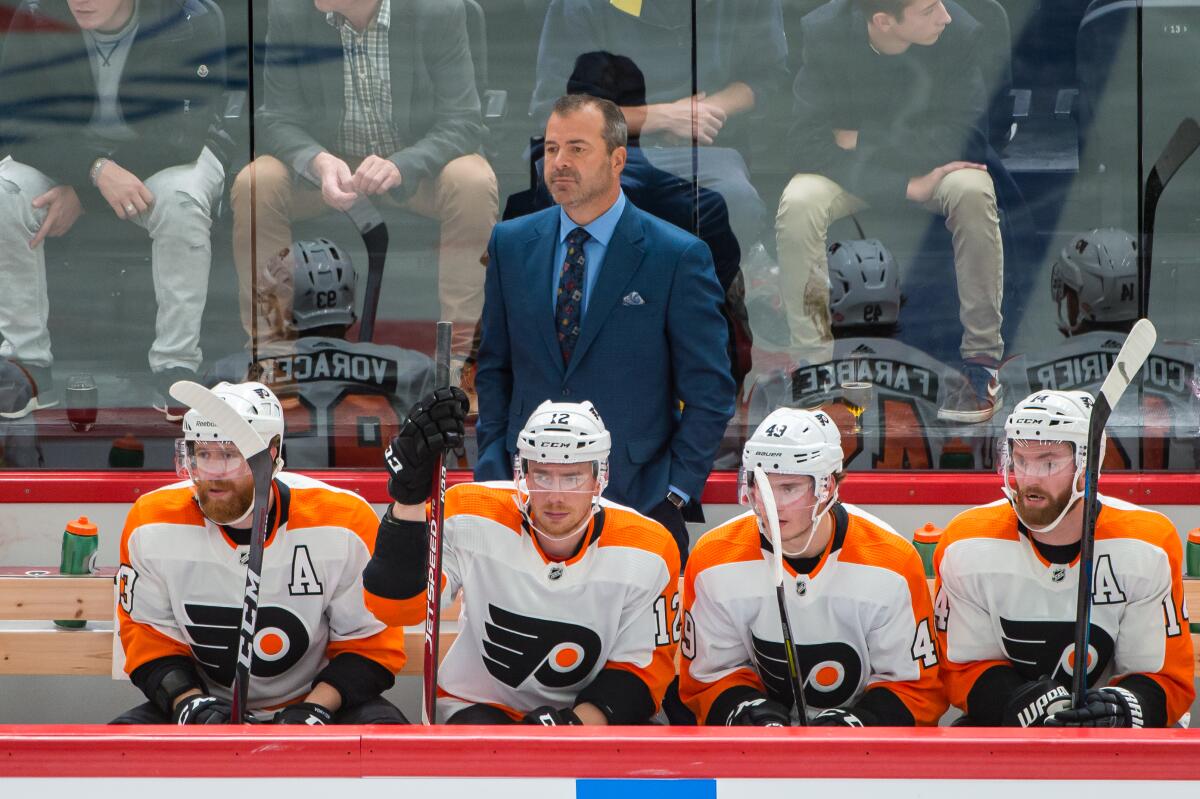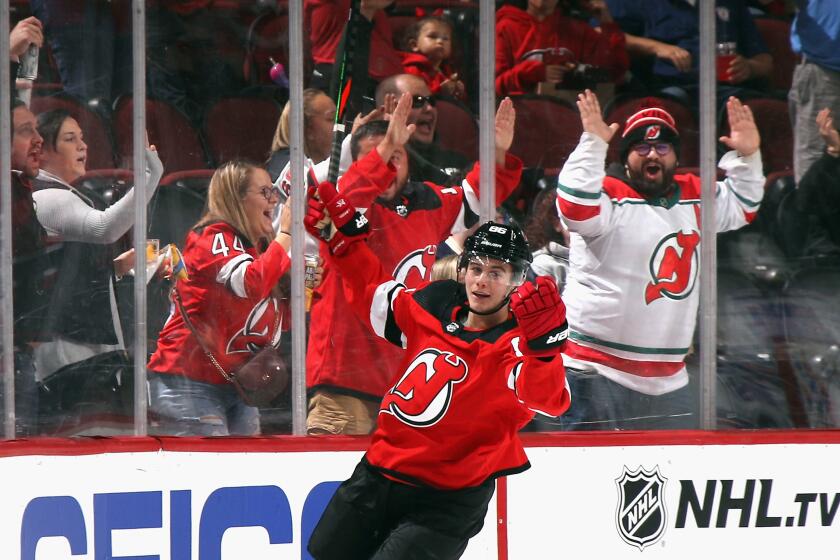Labor peace and increased scoring are the hot topics heading into NHL season

- Share via
The NHL and its players gave fans a great gift this summer.
By agreeing not to opt out of the current collective bargaining agreement — which would have expired after this season had either side chosen to end it — the league and the NHL Players’ Assn. guaranteed labor peace for the next three seasons. Commissioner Gary Bettman had imposed a hat trick worth of lockouts (1994-95, 2004-05 and 2012-13). Thankfully, he didn’t go for a grand slam.
Without the looming threat of another lockout, players and fans can focus on hockey instead of doomsday scenarios. That means everybody wins. And there’s a lot to look forward to when the 2019-20 season begins Wednesday.
An uptick in scoring continued last season when NHL teams scored an average of 3.01 goals per game, a psychologically important rise from the previous season’s per team average of 2.97. The 3.01 average was the highest since teams averaged 3.08 in 2005-06, the first season played under rules that reduced obstruction.
Those rules produced an unusually high average of 5.85 power-play opportunities per game. It’s a good sign that last year’s average climbed despite the average number of power-play opportunities falling to 2.92 per team per game.
Do the St. Louis Blues stand a realistic chance of repeating as Stanley Cup champions? Will the Kings or Ducks make the NHL playoffs?
Six players scored 100 points or more last season, led by Tampa Bay forward Nikita Kucherov’s 128. The last time that many players scored 100 points or more was in 2006-07, when seven players reached or passed that mark.
Also, two players scored 50 goals last season, Washington’s Alexander Ovechkin (51) and Edmonton’s Leon Draisaitl (50). The last season in which more than one player reached 50 was 2011-12, when Steven Stamkos had 60 for Tampa Bay and Evgeni Malkin scored 50 for Pittsburgh.
Building around speed and youth has become essential the last few seasons, and it has been a welcome trend.
But will it be reversed because the St. Louis Blues won the Stanley Cup in June by playing “heavy hockey”? There’s little innovation in the NHL and teams are inclined to copy what has succeeded elsewhere, but the Blues’ style isn’t likely to inspire widespread imitation.
It’s too difficult to play that way for a full season; the Blues knew they’d have to muscle through opponents for only 28 games at most. Being fast and playing fast will continue to be fundamental, though heavy hockey might reappear in the playoffs.

In the hired-to-be-fired department, there are seven coaches in new positions: Dallas Eakins in Anaheim, Ralph Krueger in Buffalo, Dave Tippett in Edmonton, Joel Quenneville in Florida, Todd McLellan with the Kings, D.J. Smith in Ottawa and Alain Vigneault in Philadelphia. In addition, Blues coach Craig Berube, who took over for Mike Yeo last November, had the “interim” label removed from his title.
There are four new general managers: Steve Yzerman returned to Detroit, Ken Holland moved from Detroit to Edmonton, Bill Guerin took over in Minnesota, and Kelly McCrimmon was promoted in Vegas when George McPhee was appointed director of hockey operations.
Several rule changes will take effect. Referees will be allowed to review major and match penalties by looking at a monitor and can confirm the call or reduce the infraction to a minor penalty but can’t rescind the penalty. There’s no provision to review major fighting penalties.
Referees also can review double-minor penalties for high-sticking and can confirm the call or rescind it if a review shows a teammate, not an opponent, was responsible for the infraction. The double-minor can’t be reduced to a two-minute minor. Reviews apply only to calls that have been made and can’t result in adding a penalty or increasing the severity of a penalty.
Will the New Jersey Devils see a resurgence with No. 1 pick Jack Hughes? Will the Tampa Bay Lightning try to avoid finishing first this season?
The coach’s challenge rule, which was limited to challenges for offside and goaltender interference, was expanded to include the possibility to ask for a review of a play in the offensive zone that led to a goal but should have been whistled dead, such as when pucks hit the netting above the glass, a player makes a hand pass to a teammate, or a puck is high-sticked to a teammate in the offensive zone.
The consequence for an unsuccessful challenge will be the same in all three cases: The first unsuccessful challenge will result in a minor penalty for delay of game, and a second unsuccessful challenge would result in a double-minor penalty. Coaches are permitted to ask for a review as many times as they like. Video reviews in the final minute of regulation and throughout overtime will still be handled by the Situation Room in Toronto.
Also, if a player who is on the ice loses his helmet, he will get a minor penalty unless he exits the ice or retrieves and replaces his helmet within a “reasonable” period of time. That player is permitted to make or finish a play before he must leave or replace his helmet.
A player who intentionally removes an opponent’s helmet will get a minor penalty for roughing. And in a procedural change, the offensive team will have the choice of which dot a faceoff will take place on after an icing as well as at the beginning of a power play.
The best change of all is that there’s no longer a reason to expect a lockout in the near future. Enjoy the scoring, the saves and the labor peace while you can.
More to Read
Go beyond the scoreboard
Get the latest on L.A.'s teams in the daily Sports Report newsletter.
You may occasionally receive promotional content from the Los Angeles Times.









